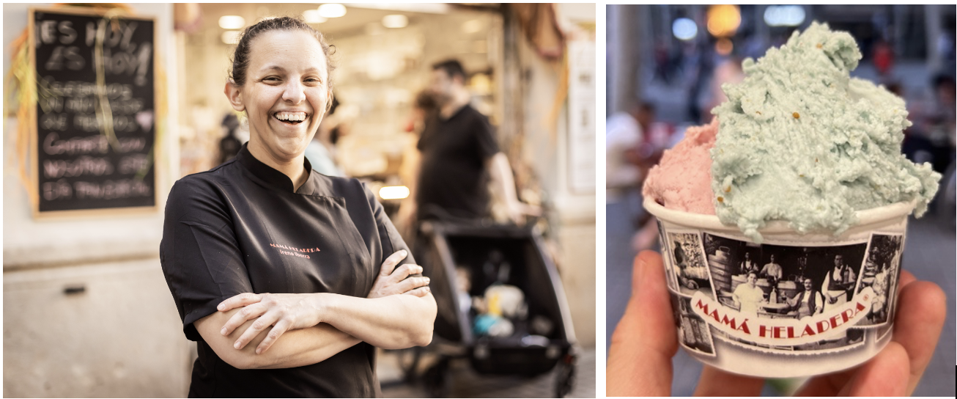Retro innovation involves evoking positive memories from the past for new products in the present. Mamá Heladera (mama’s ice cream shop) in Poble Nou, a charming village adjacent to Barcelona, is the brainchild of Irene Iborra, a 5th generation member of the family behind the popular ice cream and tiger nut milk shop, Tio Che, started by her great, great grandfather in 1912. Irene’s parents were determined that their daughter pursue a career outside of the family business and so she trained to work in the hospitality industry. After a stint working for the tourism department of the fabulous Spanish department store El Corte Ingles, Irene felt herself drawn back to the ice cream business she grew up with, that had come to mean so much the community of Poble Nou. She wanted to do it in her own way and leave her own mark.
Before returning, Irene wanted to be formally trained and she enrolled in the pastry making program at Hofmann, the top school of gastronomy in Barcelona. While there, she did a deep dive studying all she could about neurogastronomy, the study of how the brain perceives flavors by integrating inputs from all five senses, plus memory and emotion. She studied theories of most famous neurogastronomists, like François Chartier about exponential flavor combinations, and Niki Segnit about cutting-edge food pairings.
During COVID, the shop next to the original Tio Che became available and Irene decided to create her own shop dedicated to new ice cream flavors inspired bu happy memories shared by customers. Fortunately, at Hofmann she met Irene Vidal, who joined shop during the first month. Irene describes her as her right hand who made it all possible, a great chef and storyteller, which matters because Mamá Heladera’s concept is all about personal storytelling. Their work involves love, innocence, pleasure, family, happiness, community, artistry, technical skill, science, imagination, and creativity.
Anyone who hopes to see their memories turned into an ice cream flavor can fill out a form that asks them to share their fondest memories associated with events, seasons, smells, textures, sounds, tastes, where it took place, and who was there. Request forms are dropped into an old-fashioned milk pail by the shop’s entrance. Each week one of those memories is selected and turned into a totally unique ice cream flavor. The example above was a memory from a visit to Barcelona’s Tibidabo amusement park and a ride on the Ferris wheel. Other examples I saw were memories of an orchard in France and a visit to the northwest coast of Spain in summer. Flavors have names like “Trip of Adventures” for a sorbet of dragon fruit and strawberries, or “Grandma Sent Me To The Cherry Tree For A Snack” for a cherry sorbet with lavender.
Irene develops customized flavors for events including exhibitions of Tutankhamun’s tomb with symbolism in the flavors like alcohol-free beer, honey and cumin, or another of Leonardo Da Vinci with symbolism in the flavors like raspberries, honey, rose water and candied lemon, or for the Maricel Museum in Sitges during an exhibit about Modernism with a special Sitges Malvasia ice cream with vanilla, jasmine, orange blossom and roses flavor. An ice cream developed for a perfumery conference was represented by the flowers of the Cau Ferrat Museum, by vanilla as a result of commercial relations with the East in that historical period, and by the emblematic Malvasia wine of Sitges. For the hotel chain Yurbban, Irene developed a signature ice cream flavor inspired by the hotel’s cedar and green cardamon scent. She has even developed special flavors for couples for their wedding or anniversary.
Irene is a great example of a cross-pollinator that others learn from. She has run workshops with executives from the perfume company, Eurofragance, to help them think about how:
- Multisensory dimensions evoke emotions and memories, and influence perceptions
- Experiences can be incorporated into not only flavors and textures, but also into fragrances
- Different people experience the same flavors and scents differently
- Different scents evoke different memories for each person
- The way tastes are perceived is affected by what was eaten immediately before
Memories of romance, relationships, and when couples first meet are among the most powerful. For a couple who was planning a wedding, and another who was celebrating a 10-year anniversary, in preparation for developing their signature flavors for their celebrations, Irene asked them to identify together how they first met, a favorite trip they took together, and a favorite routine they enjoy doing together. For each experience they were asked to recall the aromas and flavors they associated with that time. Finally she asked, of all the memories they remembered, which they thought would endure 10, 20, 30 or 40 years in the future. The couple that celebrated their 10th anniversary recalled happy summers and the sparkle they feel when they’re together. The flavor Irene developed that embodied those memories combined regular peaches, donut peaches, apricots, vanilla, and electric flower, a dehydrated flower that produces a sensation similar to champagne bubbles on the tongue.
Products succeed because of how they make people feel. Every detail matters. Multi-sensory experiences can be particularly profound and make products far more memorable. Brands should think about how to incorporate multi-sensory and experiential aspects into their products that can become part of customer’s stories and personal identities.

